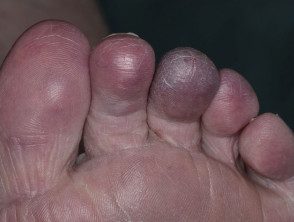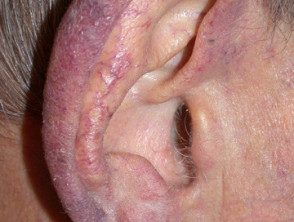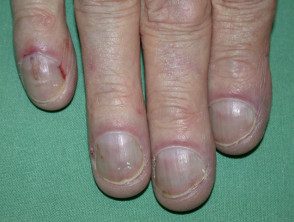What is acrocyanosis?
Acrocyanosis is functional peripheral vascular disorder characterized by dark mottled discoloration, or cyanosis, of the hands, feet and sometimes the face.
Acrocyanosis is caused by the spasm of the small vessels in the skin in response to the cold. Can be primary or secondary1,2
Who gets acrocyanosis?
Primary acrocyanosis occurs more frequently in adolescents and young adults (the onset is usually between 20 and 30 years old) 1,2
- It is more common in women than in men.
- Acrocyanosis is rarely seen in children or postmenopausal women.
- May coexist with chilblains, erythromelalgia, or Raynaud's phenomenon.
Secondary acrocyanosis can occur at any age, depending on the underlying cause.
What causes acrocyanosis?
The causes of acrocyanosis depend on whether it is primary or secondary.1–3
Primary acrocyanosis
Primary acrocyanosis is genetically determined or of unknown origin. Not associated with occlusive arterial disease. Chronic small vasospasm cutaneous arterioles or venules results in secondary dilation of capillaries and the subpapillary venous plexus.
Secondary acrocyanosis
Factors contributing to secondary acrocyanosis may include:
- Hypoxemia, often due to lung disease or smoking
- Connective tissue diseases (eg, granulomatosis with polyangiitis, rheumatoid arthritislupus erythematosus overlay syndrome)
- Neoplasms (for example, Hodgkin lymphomaovarian Cancer)
- Occlusive arterial diseases (peripheral vascular disease)
- Eating disorders and malnutrition.
- Hematological disorders
- Drugs and toxins
- Infections
- Atopic dermatitis
- Hereditary diseases (eg, Mitochondrial disease, Down syndrome, Ehlers-Danlos syndrome)
- Childhood
- Buerger's disease
- Spinal cable injury
- Atrophic rhinitis
- Psychiatric/ psychological reasons
What are the clinical features of acrocyanosis?
Primary acrocyanosis
Primary acrocyanosis is presented with bilateral, symmetricalPersistent, painless blue discoloration of fingers and toes. Acrocyanosis can be extended to include hands, feet, and face. Pressure on an area of pallor leads to a slow and irregular return of blood from the periphery to the center (Crocq sign) Arterial pulses are normal and there is no proximal pallor, ulceration or gangrene. 1,2,4
The clinical features of acrocyanosis may also include:
- Hyperhidrosis hands and feet
- Cold hands and feet
- Swelling digits
Secondary acrocyanosis
The presentation of secondary acrocyanosis varies depending on the underlying cause. Secondary acrocyanosis is often asymmetric and it is associated with pain and tissue damage (blue toe syndrome).
Signs of a primary disorder may be present.
Secondary acrocyanosis

Secondary acrocyanosis

Secondary acrocyanosis

Secondary acrocyanosis
How is acrocyanosis diagnosed?
The clinical diagnosis of acrocyanosis is based on the general appearance of the patient and the distribution and persistence of cyanosis.1,2,5
In young adults, where the diagnosis is most likely to be primary acrocyanosis, only limited research is required.
In older adults, or if there is atypical Features such as acrocyanosis pain and asymmetry will require specific background, examinations, and investigations to determine the cause. Investigations may include:
- Pulse oximetry
- Urine analysis
- Full blood count, C-reactive protein, ESR
- Standard biochemistry that includes liver and kidney function.
- Streptococcal titles
- Autoantibodies
- Immunoglobulins and plasma electrophoresis
- Complement studies
- Chest x-ray
- Venous and arterial blood gas measurements
- Skin biopsy
- Nail fold capillaroscopy (to distinguish primary cyanosis from early-stage connective tissue disorders).
What is the treatment for acrocyanosis?
Primary acrocyanosis
Treatment is not required for most patients with acrocyanosis and pharmacological intervention is rarely necessary.1,5 The patient should be assured that the condition is harmless. Options for active management can include:
- Behavioral measures, such as avoiding exposure to cold and trauma
- Psychophysiological measures, such as biofeedback training, reflex conditioning, and hypnosis.
Note that vasodilators, for example calcium channel blockers, are not helpful (unlike Raynaud's phenomenon).
- There is limited evidence of benefit of bioflavonoids, nicotinic acid derivatives, adrenergic blockers, current minoxidil, cyclandelate, rutin compounds and bromocriptine.
- Sympathectomy It can be considered in very severe cases.
Secondary acrocyanosis
The treatment of secondary acrocyanosis depends on the underlying cause.
What is the result of acrocyanosis?
Primary acrocyanosis is a benign condition that usually resolves in middle age without long term aftermath.
Secondary acrocyanosis can be resolved by treating the primary cause. As the pathological mechanisms that cause secondary acrocyanosis vary, so does forecast.
